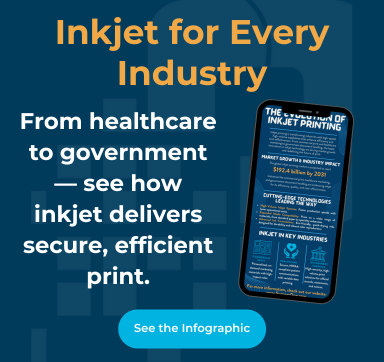
In higher education, cybersecurity is often seen as an IT department concern, but every connected device on campus plays a role in the school’s overall security posture. In-plant print centers are no exception.
From student transcripts and financial aid packets to HR files and research data, campus print systems handle a massive amount of sensitive information daily. Yet, many in-plants don’t realize that their networked printers and multifunction devices can be an open door for cyberattacks if not adequately secured.
The Overlooked Risk: Printers on the Network
Modern in-plants rely on connected print workflows to boost efficiency and productivity. But these same connections can expose vulnerabilities when devices are left unprotected or outdated.
Common risks include:
- Unsecured network access – Printers often retain default passwords or open network ports, making them easy entry points for hackers.
- Unencrypted print jobs – Without proper encryption, print data can be intercepted in transit.
- Stored sensitive data – Many devices store copies of printed, scanned, or faxed documents on internal hard drives.
- Outdated firmware – Failing to update printer firmware leaves known vulnerabilities exposed.
Suppose even one device in the print fleet is compromised. In that case, attackers can gain access to broader campus systems — and the consequences can be severe, from data leaks to regulatory non-compliance.
Practical Steps for Securing In-Plant Print Systems
Cybersecurity doesn’t have to be complex or costly. By implementing a few key best practices, higher ed in-plants can significantly reduce their risk.
- Secure the network connection
- Require strong passwords and turn off unused ports.
- Use secure print protocols (e.g., IPPS, HTTPS).
- Segregate printers on a dedicated VLAN to isolate them from core academic systems.
- Keep firmware and software up to date
- Enable automatic updates or schedule regular maintenance windows.
- Work with your print provider to ensure all devices receive timely security patches.
- Encrypt data — in transit and at rest
- Activate encryption for stored jobs and hard drives.
- Require authentication for printing, scanning, or releasing jobs at the device.
- Implement user authentication and tracking
- Use ID cards, PINs, or SSO integrations for secure print release.
- Track print activity to detect anomalies or misuse.
- Educate and empower staff
- Train in-plant teams on data handling and security protocols.
- Make cybersecurity a shared responsibility, not just IT’s domain.
Partnering for Print Security
While many higher ed institutions focus their cybersecurity strategies on servers and student systems, print environments are often the missing piece of the puzzle. A managed print partner like SumnerOne helps institutions bridge that gap — ensuring every device, workflow, and document is secured end-to-end.
Our approach includes:
- Network security assessments for print environments
- Secure print management and device hardening
- Data encryption, authentication, and tracking solutions
- Ongoing support and monitoring
Cybersecurity isn’t just IT’s job — it’s everyone’s responsibility, from the server room to the print shop floor.
With connected print systems at the heart of many academic workflows, higher education in-plants must stay vigilant, proactive, and prepared. By combining innovative policies with secure technology and the right partner, your campus print operation can remain both productive and protected.
Protect your institution’s sensitive data with end-to-end print security solutions. Contact us today to schedule a print security assessment.
 FREE EBOOK DOWNLOAD
FREE EBOOK DOWNLOAD
















